Keeping cords organized and hidden on a computer desk can be quite challenging, especially when too many devices are used in the setup and require power and connectivity.
These messy cords can make your workspace disorganized and make you frustrated and inefficient while working and also lead to a safety hazard.
Luckily, there are many clever methods and hacks to help you hide these tangled cords on your computer desk and achieve a more organized, clean, and tidy workspace.
In this article, we’ll discuss how to hide cords on desks and explore different cable management solutions and tools to help you keep your cords under control.
Important Consideration Before Hiding Cords on a Desk
Before we discuss how to hide cords on desks and explore the methods, there are a few important things you need to consider.
1. Placement of Your Desk
The placement of your computer desk is the most important aspect which will determine how you would be hiding the cords of your computer peripherals.
For example, if your office desk is in the middle of the room or the power outlet is far away from your office desk, you’ll get yourself into trouble hiding the cords.
You’ll have to route all the power cords of equipment to the power outlet to plug in which will make all of the power cords clearly visible in the setup.
But, hiding the cords will be less stressful and much easier if you’ve set up the computer desk with the wall or near the power outlet can help you
2. Number of Equipment You Use
Organizing or hiding one or two cords is not a big deal but what is really stressful is a bunch of cords and cables of several devices.
The more electronic devices and peripherals you use in the setup, the more cables are on the desk, and you’ll have to struggle with hiding them.
And suppose the power cords are more than the available power sockets, you’ll end up adding additional power outlets, which could be frustrating. Isn’t it?
3. Desk Type Your Setup Has
The type of desk you have in your setup is another factor that determines what kind of cable management solution you would be implementing.
Since the computer desk comes in different built materials, they require specific cable management solutions and tools based on their built material.
For example, hiding the cords on a wooden computer desk would be much easier and more convenient than a metal desk because they have a thick structure.
On the flip side, hiding the cables on a glass desk is more stressful than a wooden or metal computer desk because they are see-through.
4. Permanent vs Flexible Solution
When deciding on how to hide cords on a computer desk, it’s important to consider permanent and flexible solutions before you proceed.
And the reason is that in some cases, you just need a few changes in your setup in a short time without causing damage to your desk or anything.
A permanent solution is good when a long-term and the aesthetically pleasing way is needed to conceal cords, whereas a flexible solution works well when you want to be able to change and move things around easily.
5. Arrangement of Your Devices
Consider setting up each possible device that your setup might have and then arrange them in a way so accessing their cords becomes more convenient.
For example, all electronic equipment like monitor, PC tower, laptop, printer, etc is placed in a way so sorting their power cables are easy.
And all USB devices such as the keyboard, Mouse, USB speakers, USB Hub, Charging Station, etc are organized in a way so sorting their USB wires are easy.
Arranging all the devices in a proper way will help you determine where the cords need to go and how you can properly conceal them.
Now let’s explore all the practical ways to hide cords on a computer desk.
How To Hide Cords On Desks: 17 Smart Ways
1. Position Your Desk Near the Electric Outlet
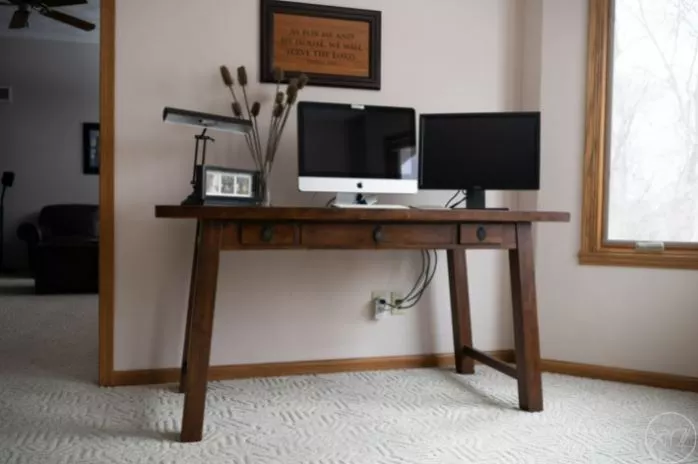
The easiest way to hide the cords of your computer and other electronics is to set up your computer desk just near where the power outlet is.
By positioning your computer desk to the nearest possible electrical outlet, you can plug in your electronic equipment to the source by using limited lengths cords.
A short power cable will be long enough to reach the power source and you will be able to power all the devices without having to route power cables around.
By doing this implementation, very few parts of the power cable will be visible and you will not have to use any cable management tools to hide them out of sight.
2. Conceal Computer Wires on the Wall
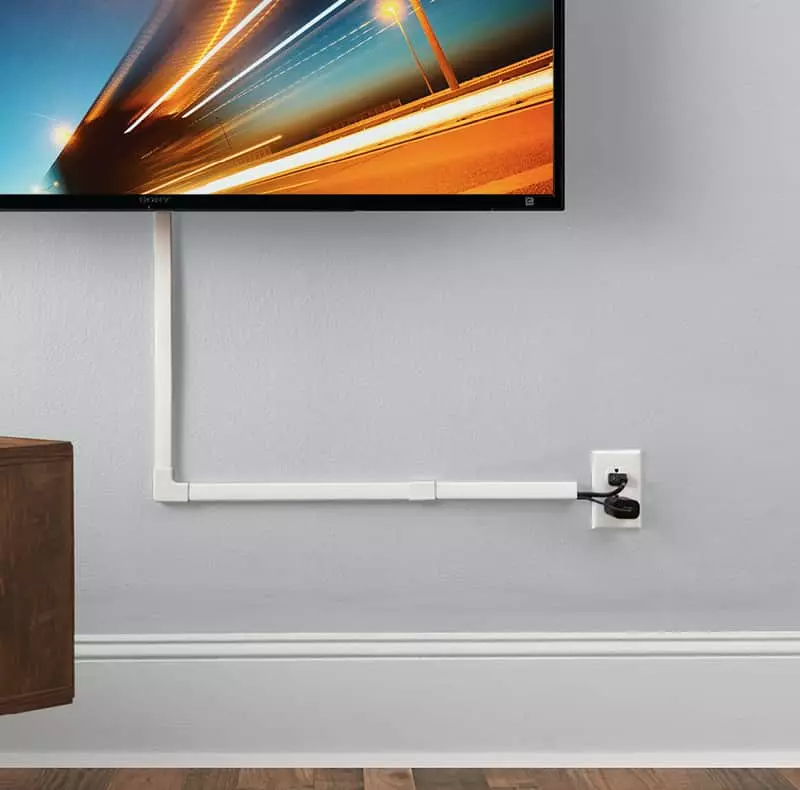
If you aren’t able to take your desk to the nearest possible power outlet but you want to hide the visible cords on your desk, you can use the cable management raceway.
This cable channel allows you to stick them on the wall with adhesive and neatly covers the cords for clean and organized aesthetics.
All you need to do is measure the path where the cords need to go and cut the cable management raceway to the measured length and stick them to the wall.
Now, you need to put all the power cords inside this cord raceway one by one precisely and run them to the power socket so you can plug them into the power source.
If the cord raceway isn’t wide enough to fit multiple cords altogether, use a wider cable raceway, or you can stick another cable raceway just next to the first one.
Once you’ve done routing all the power cords, you only need to put the cover of the cable raceway, and all cords are hidden neatly.
The best thing is that these cable covers come in various colors or you can paint them over to match your room’s aesthetics.
3. Hide Cords on the Back of the Desk Legs and Frame
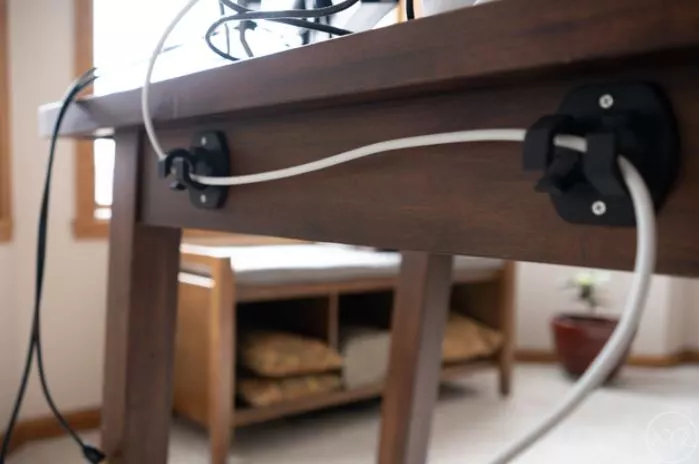
Many of you must have an office desk with thick legs and frame and believe me, you have a great opportunity to hide the cords on your desk.
The solution is that you can hide the wires of your computer and other peripherals on the back of your desk legs and frame.
To make this implementation, you’ll only require some cable clips with adhesive sides which are a great tool to help you hide the cords neatly.
All you need to do is stick the cable clips back of the desk legs and frame and route the cords on a certain path and keep them effectively tucked in places.
4. Hide the Cables Under the Desk
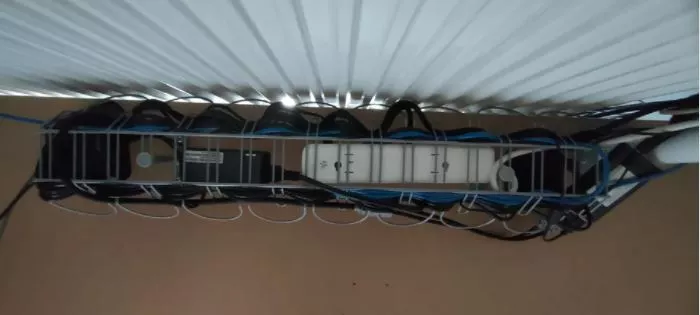
If there is a power strip, laptop charger, and many cords on your desk that you want to hide to keep the workspace tidy, you can hide them under your office desk.
An under-desk cable management tray is a kit that can help you in this situation to keep the power strip, laptop charger, and cords tucked under the desk.
Consider getting an under-desk cable management tray and attaching them underneath the desk with screws or nails provided with the kit.
Now, put the power strip, laptop charger, and cords on it and it will leave an empty workspace where you can keep other essential office supplies.
5. Hide Computer Cords on the Desk
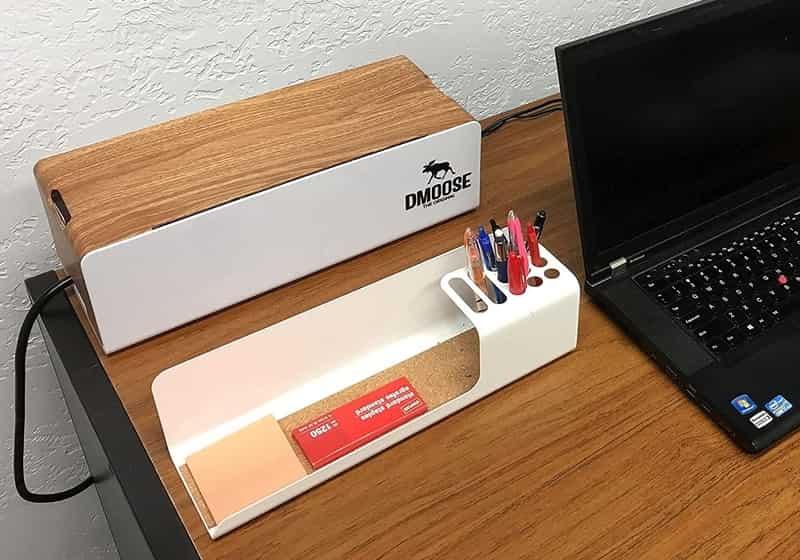
If you’re using an additional power strip on your desk that you want to hide, you can hide them on your desk by utilizing a power strip box.
Consider getting a cable management box or power strip box and putting the external power supply inside it that you’re using on your desk.
Its wide design not only allows you to keep the power strip hidden but also cords and small items are hidden and helps to keep your workspace less cluttered.
It also comes in a range of colors and designs so you don’t have to be concerned about the aesthetic of your home office.
6. Hide Cords in the Middle of the Room

Sometimes, cords must be run across the floor since the electrical outlets aren’t near your desk. In such a case, you won’t be able to keep them hidden in any box or tray.
And since power cords can be a safety hazard, they need to be covered as soon as possible especially, if you prefer to work barefoot.
A simple yet effective solution to keep the floor cords covered is to utilize a floor cord cover protector.
The floor cord cover protector has an adhesive back that allows you to stick them onto the floor and run cords along it keeping them hidden from view.
The only downside is that it may look your floor a bit ugly if it’s in a different color to your floor and installing it on the carpet floor requires cutting in the carpet.
7. Add Cable Management Features to Your Desk
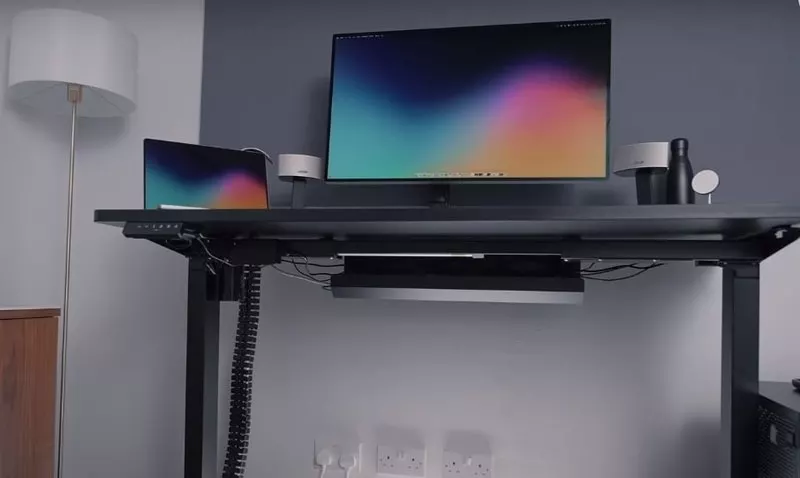
Adding cable management features to your office desk could be a wonderful way to hide computer wires and keep them easily accessible when needed.
The cable management tray and J-channel cable raceway are flexible options as they come with self-adhesive tape or are mounted using simple screws.
So, consider getting any of the tools that suit your desk and attaching it to your desk, and voila, the office desk has cable management abilities.
8. Use Fewer Peripherals as Possible

The fewer devices you use at your desk, the fewer cords you have at your desk. So sometimes using fewer peripherals can help you hide cords on the desk.
For example, if your office work does not require scanning or printing, you can remove the printer and scanner from your office desk.
This way you’ll certainly be able to get rid of 2 extra power cables and 2 USB cables, a total of 4 cords from your office desk.
And if you find yourself mostly working in daylight, you can even remove the desk lamp and avoid its cable trailing on your work surface.
9. Go for Wireless Office Setup
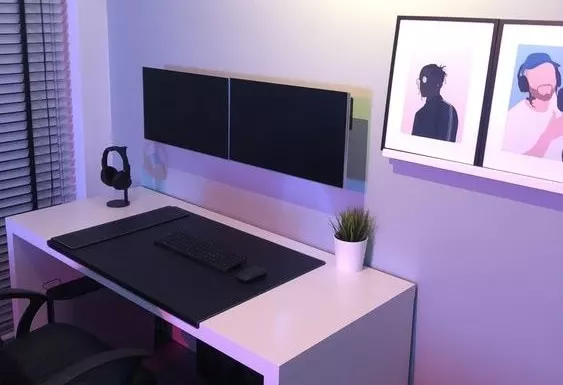
Upgrade your USB peripherals to wireless once and you’ll amazingly be able to minimize cords completely on your desk and have a clean and neat workspace.
Although, this is a great cord-free desk solution for the one who is building their setup from scratch because investing in wireless devices can be pricy.
But, if you want a clean and organized workspace for long-term use, switching over to a wireless setup could be worth thinking about.
10. Utilize the Desk Drawers to Store Power Strip
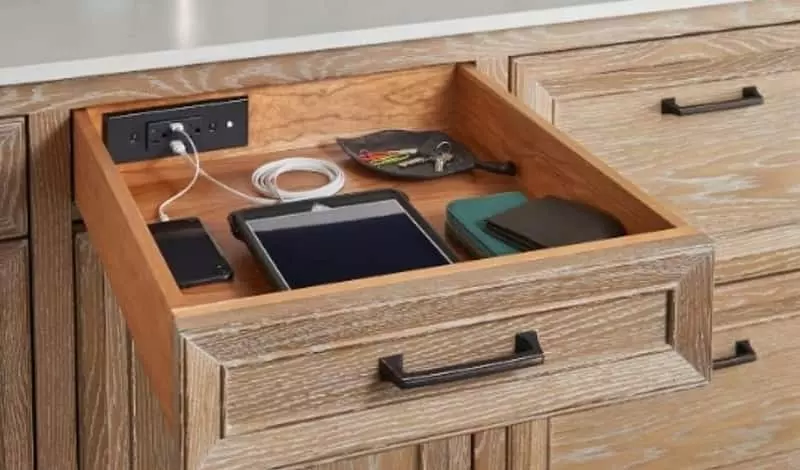
If you have a desk with drawers or cabinets, you can smartly utilize them to hide some extra cords and wires and maintain a neat and tidy desk space.
You don’t have to be so creative to implement this solution, a little DIY can be helpful to make this change in the drawer.
You just have to make a hole in the back of the drawer to come out the cords through it so you can keep the cords tucked away in the drawer.
Once you’ve made a hole, put the power strip in the drawer, plug all the cables into it, and route the rest of the cables through the desk frame to the devices.
11. Keep Extra Adapters Stored
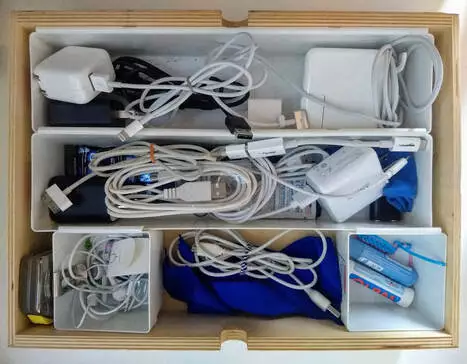
You can also make use of your desk drawers and cabinets for storing extra adapters and chargers that aren’t in use and can keep them from getting tangled.
For example, your setup might have several adapters and your mobile, tablet, and smartwatch chargers which you don’t use frequently.
If these chargers and adapters are always plugged in even when you aren’t charging any device, these tangled wires and cables can make your setup more cluttered and messy.
So, it’s good practice to keep them unplugged and stored in the drawer until you need them. This is how it helps you hide extra wires on your desk.
12. Arrange Cords in a Decorative Way
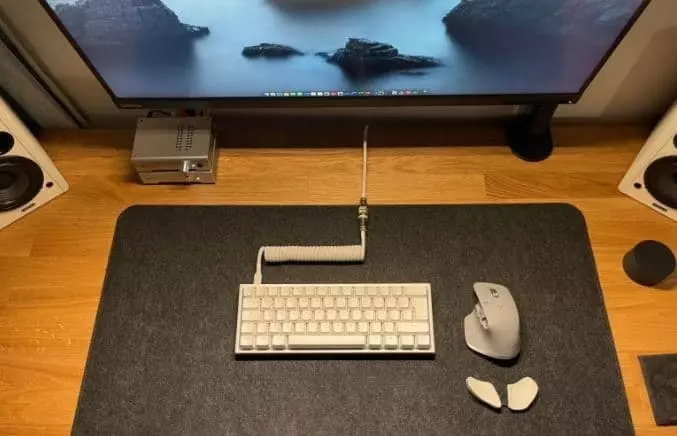
Sometimes, leaving wires and cables in an organized way is the best solution instead of hiding them using tools and kits.
Decorate the wires and cables by wrapping them in colorful threads or tubing so they don’t look like a cord but like decorative items in your setup.
You can replace your keyboard and mouse cables with coiled cables or you can turn them into coiled cables on your own with a little DIY.
This will amazingly shorten the extra-long cables of your setup and turn them into fun components of your workspace.
13. Make Use of Accessories & Decor

Your setup might have many office supplies and items such as books, folders, binders, plants, etc which you can use to hide wires on your setup.
Believe me, accessorizing your desk with these items can not only make your setup aesthetically wow but can prove to be useful for hiding cords.
Place your office supplies in front of power strips, adapters, switches, etc and this way, you’ll be able to hide extra wires from sight.
You can even run the wires behind the bookshelf if your desk has one, and the wires will completely be concealed behind the bookshelf.
14. Mount Your Monitor Above the Desk
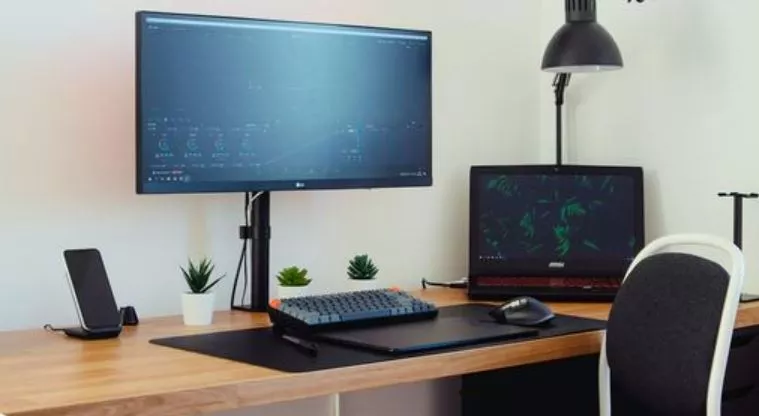
Another smart way to minimize obvious cords on the desk is to mount the monitor above the desk via wall mount or desk mount.
Mounting the monitor not only gives you ease to manage the cords but also frees up your desk space for maintaining a clean and tidy workspace.
You can have a floating monitor on the wall with concealed cords using cords covers or have a desk-mounted monitor setup with built-in cable management.
15. Make a Hole in Your Desk
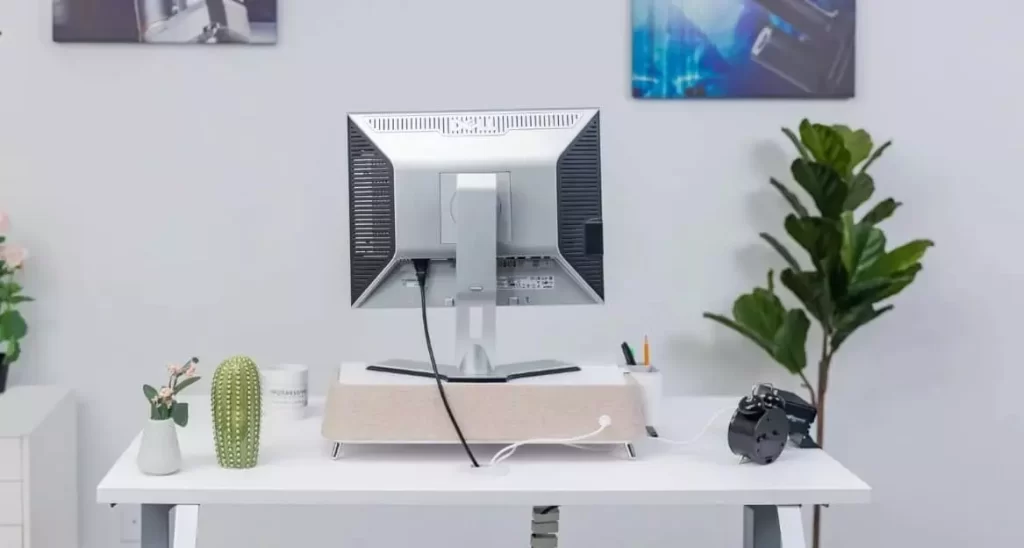
To keep your desk cord-free and tidy, you can make a hole in the back of your desk and run the wires through it so they are completely hidden from view.
But attempting this solution will require proper tools as well as skills in how-to. So it’s recommended you take advice from any professional before you proceed.
Or you can buy a desk with a pre-made hole for cord management and this computer desk is one such option at a reasonable cost.
16. Stick to Aesthetic Desk Setups
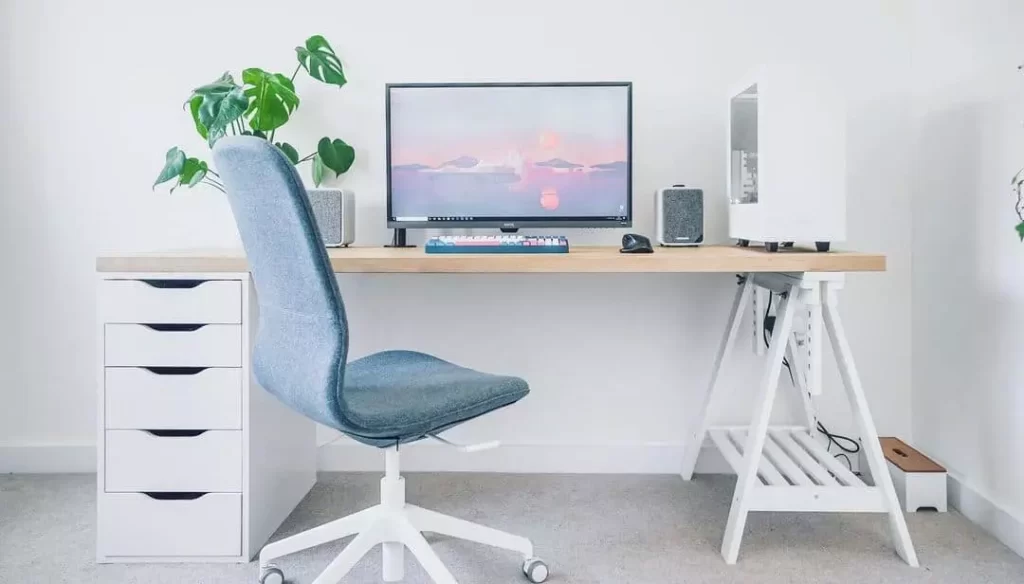
You would be surprised to know how an aesthetic desk setup can help you hide cords on your computer desk and have a neat and clean desk setup.
An aesthetic desk setup is creating a visually pleasing and organized arrangement of items on a desk, including a combination of functional and decorative items.
To minimize the obvious cords on your desk, you can use organizers, plants, and lighting and decorate them in a way that looks visually appealing.
But ensure you stick with a single color scheme for the most aesthetic appearance where the black and white theme is the most common option.
Get all of your setup accessories in a single color. This way hiding cords will be much easier and they will be less noticeable even if they are in sight.
17. Use Desk with Cord Management Feature
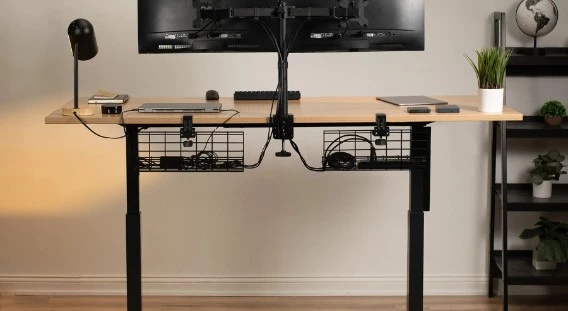
If you’re building your setup from scratch and thinking about cord management, there is no better option than having a desk with built-in cable management.
Buy a computer desk with an integrated cord management system so you can nicely stow the cable inside and keep them away from view.
And this Armocity computer desk is one such option that has a built-in power outlet and USB charging station along with large storage shelves for keeping things stored in place.
Video Tutorial on How to Hide Computer Cords on Desk
FAQ: How to Hide Computer Cords on Desk
1. How to hide computer cords in the middle of the room?
The solution to hiding computer cords in the middle of the room is to add a rug or floor cord cover on top of the computer cords to cover it so cords don’t appear.
2. How can I hide computer cords behind my desk?
You can hide computer cords behind your desk by making a hole in the back of your desk and routing the cords through it, or you can attach a cable tray under your desk and keep cords tucked underneath, or you can stick cable clips on the back of the desk to keep cords tucked in a certain path.
3. How to hide computer wires behind the monitor?
If you have a monitor with a stand, you can group all the wires and route them through the monitor stand by attaching them behind the monitor.
Conclusion
Hiding cords and wires on a computer desk is an essential part of creating a clean and organized workspace and preventing electric hazards.
There are endless ways to hide cords on desks ranging from implementing DIY hacks on your own to buying a desk with a built-in cord management system.
Using these methods, you can significantly reduce visible cords on your desk and minimize the risk of accidents caused by tangled cords.
Implementing these solutions will also enhance the aesthetics of your desk setup as well as help you to work more efficiently and productively.
Read more:
